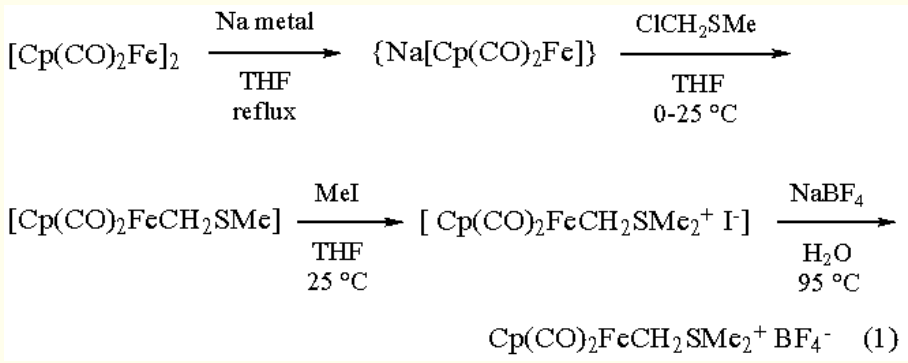dicarbonylcyclopentadienyl(dimethylsulfoniummethylide)iron
|
|
|
- CAS-Nr.
- 72120-26-4
- Englisch Name:
- dicarbonylcyclopentadienyl(dimethylsulfoniummethylide)iron
- Synonyma:
- dicarbonylcyclopentadienyl(dimethylsulfoniummethylide)iron;Dicarbonyl(cyclopentadienyl)[(dimethylsulfonium)methyl]iron Tetrafluoroborate
- CBNumber:
- CB52078976
- Summenformel:
- C10H7BF4FeO2S
- Molgewicht:
- 333.87
- MOL-Datei:
- 72120-26-4.mol
|
dicarbonylcyclopentadienyl(dimethylsulfoniummethylide)iron Eigenschaften
- Schmelzpunkt:
- 129-130 °C
- Dichte
- 1.57 g cm-3
- L?slichkeit
- insol or slightly sol most solvents at rt; sol very polar solvents such as nitromethane at rt; sol other polar solvents (e.g. dioxane) at reflux.
- Aggregatzustand
- powder or crystals
- Farbe
- yellow-orange
Sicherheit
- Risiko- und Sicherheitserkl?rung
- Gefahreninformationscode (GHS)
| Bildanzeige (GHS) |

|
| Alarmwort |
Warnung |
| Gefahrenhinweise |
| Code |
Gefahrenhinweise |
Gefahrenklasse |
Abteilung |
Alarmwort |
Symbol |
P-Code |
| H302 |
Gesundheitssch?dlich bei Verschlucken. |
Akute Toxizit?t oral |
Kategorie 4 |
Warnung |
![GHS hazard pictograms]() src="/GHS07.jpg" width="20" height="20" /> src="/GHS07.jpg" width="20" height="20" /> |
P264, P270, P301+P312, P330, P501 |
| H312 |
Gesundheitssch?dlich bei Hautkontakt. |
Akute Toxizit?t dermal |
Kategorie 4 |
Warnung |
![GHS hazard pictograms]() src="/GHS07.jpg" width="20" height="20" /> src="/GHS07.jpg" width="20" height="20" /> |
P280,P302+P352, P312, P322, P363,P501 |
| H315 |
Verursacht Hautreizungen. |
Hautreizung |
Kategorie 2 |
Warnung |
![GHS hazard pictograms]() src="/GHS07.jpg" width="20" height="20" /> src="/GHS07.jpg" width="20" height="20" /> |
P264, P280, P302+P352, P321,P332+P313, P362 |
| H319 |
Verursacht schwere Augenreizung. |
Schwere Augenreizung |
Kategorie 2 |
Warnung |
![GHS hazard pictograms]() src="/GHS07.jpg" width="20" height="20" /> src="/GHS07.jpg" width="20" height="20" /> |
P264, P280, P305+P351+P338,P337+P313P |
| H332 |
Gesundheitssch?dlich bei Einatmen. |
Akute Toxizit?t inhalativ |
Kategorie 4 |
Warnung |
![GHS hazard pictograms]() src="/GHS07.jpg" width="20" height="20" /> src="/GHS07.jpg" width="20" height="20" /> |
P261, P271, P304+P340, P312 |
| H335 |
Kann die Atemwege reizen. |
Spezifische Zielorgan-Toxizit?t (einmalige Exposition) |
Kategorie 3 (Atemwegsreizung) |
Warnung |
![GHS hazard pictograms]() src="/GHS07.jpg" width="20" height="20" /> src="/GHS07.jpg" width="20" height="20" /> |
|
|
| Sicherheit |
| P261 |
Einatmen von Staub vermeiden. |
| P264 |
Nach Gebrauch gründlich waschen. |
| P264 |
Nach Gebrauch gründlich waschen. |
| P271 |
Nur im Freien oder in gut belüfteten R?umen verwenden. |
| P280 |
Schutzhandschuhe/Schutzkleidung/Augenschutz tragen. |
| P302+P352 |
BEI BERüHRUNG MIT DER HAUT: Mit viel Wasser/... (Hersteller kann, falls zweckm??ig, ein Reinigungsmittel angeben oder, wenn Wasser eindeutig ungeeignet ist, ein alternatives Mittel empfehlen) waschen. |
| P304+P340 |
BEI EINATMEN: Die Person an die frische Luft bringen und für ungehinderte Atmung sorgen. |
| P305+P351+P338 |
BEI KONTAKT MIT DEN AUGEN: Einige Minuten lang behutsam mit Wasser spülen. Eventuell vorhandene Kontaktlinsen nach M?glichkeit entfernen. Weiter spülen. |
| P312 |
Bei Unwohlsein GIFTINFORMATIONSZENTRUM/Arzt/... (geeignete Stelle für medizinische Notfallversorgung vom Hersteller/Lieferanten anzugeben) anrufen. |
| P321 |
Besondere Behandlung |
| P332+P313 |
Bei Hautreizung: ?rztlichen Rat einholen/?rztliche Hilfe hinzuziehen. |
| P362 |
Kontaminierte Kleidung ausziehen und vor erneutem Tragen waschen. |
|
dicarbonylcyclopentadienyl(dimethylsulfoniummethylide)iron Chemische Eigenschaften,Einsatz,Produktion Methoden
Verwenden
Dicarbonyl(cyclopentadienyl)[(dimethylsulfonium)methyl]iron Tetrafluoroborate is used as a stable precursor of a cationic carbene, or methylene, complex of iron; reacts directly with alkenes to give cyclopropanes.
[1]
synthetische
the preparation of Dicarbonyl(cyclopentadienyl)[(dimethylsulfonium)methyl]iron Tetrafluoroborate has gone through several revisions and improvements since its introduction in 1979. The most
recently improved preparations
[2] are satisfactory for large-scale applications and have been adapted for commercial use. In a one-pot operation, the
stable, crystalline, dinuclear complex [Cp(CO)2Fe]2 is reductively cleaved with sodium dispersion to generate a THF solution of the highly
nucleophilic sodium ferrate, Na[Cp(CO)2Fe]. This species is immediately alkylated with chloromethyl methyl sulfide, and the resulting iron alkyl,
Cp(CO)2FeCH2SMe, is subjected to S-alkylation with methyl iodide. Finally, the resulting sulfonium salt, initially produced as an iodide, is subjected
to in situ anion exchange and simultaneous crystallization by treatment with hot aqueous NaBF4, followed by cooling to give the reagent as a yellow-orange, or amber-colored, crystalline solid (eq 1) which has been characterized spectroscopically and by single-crystal X-ray diffraction.
[3] The anion
exchange is performed in order to assure that a nonnucleophilic counterion is present during the subsequent cyclopropanation reactions; a nucleophilic
anion such as iodide may apparently intercept reactive intermediates on the pathway leading to the desired cyclopropane products. A remarkable
property of the reagent is its unusually high stability compared to most other organometallic reagents. This point is especially clear from the fact that it
can be recrystallized from hot water exposed to the air.

dicarbonylcyclopentadienyl(dimethylsulfoniummethylide)iron Upstream-Materialien And Downstream Produkte
Upstream-Materialien
Downstream Produkte
dicarbonylcyclopentadienyl(dimethylsulfoniummethylide)iron Anbieter Lieferant Produzent Hersteller Vertrieb H?ndler.
Global( 1)Lieferanten
- dicarbonylcyclopentadienyl(dimethylsulfoniummethylide)iron
- Dicarbonyl(cyclopentadienyl)[(dimethylsulfonium)methyl]iron Tetrafluoroborate
- 72120-26-4

